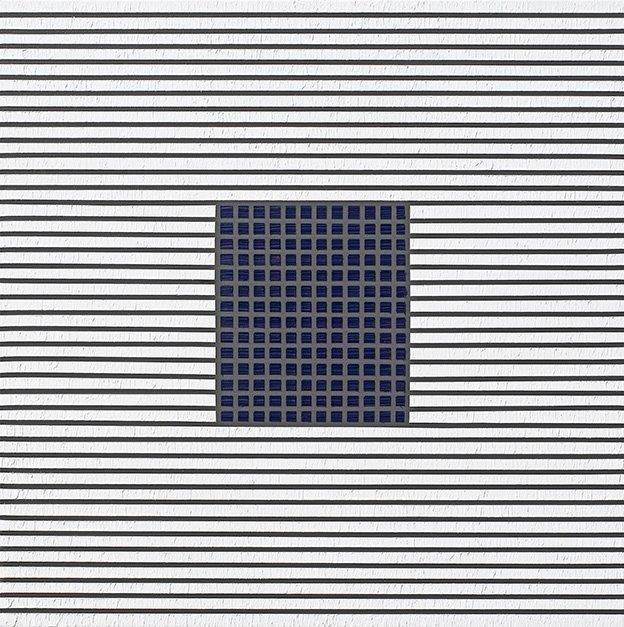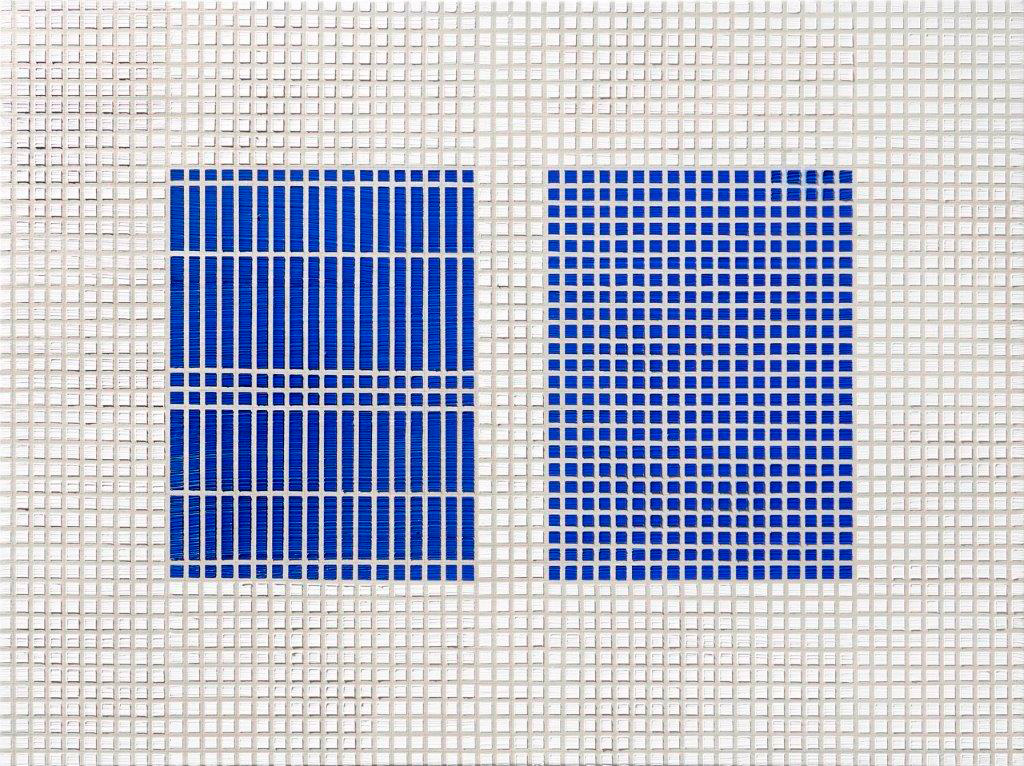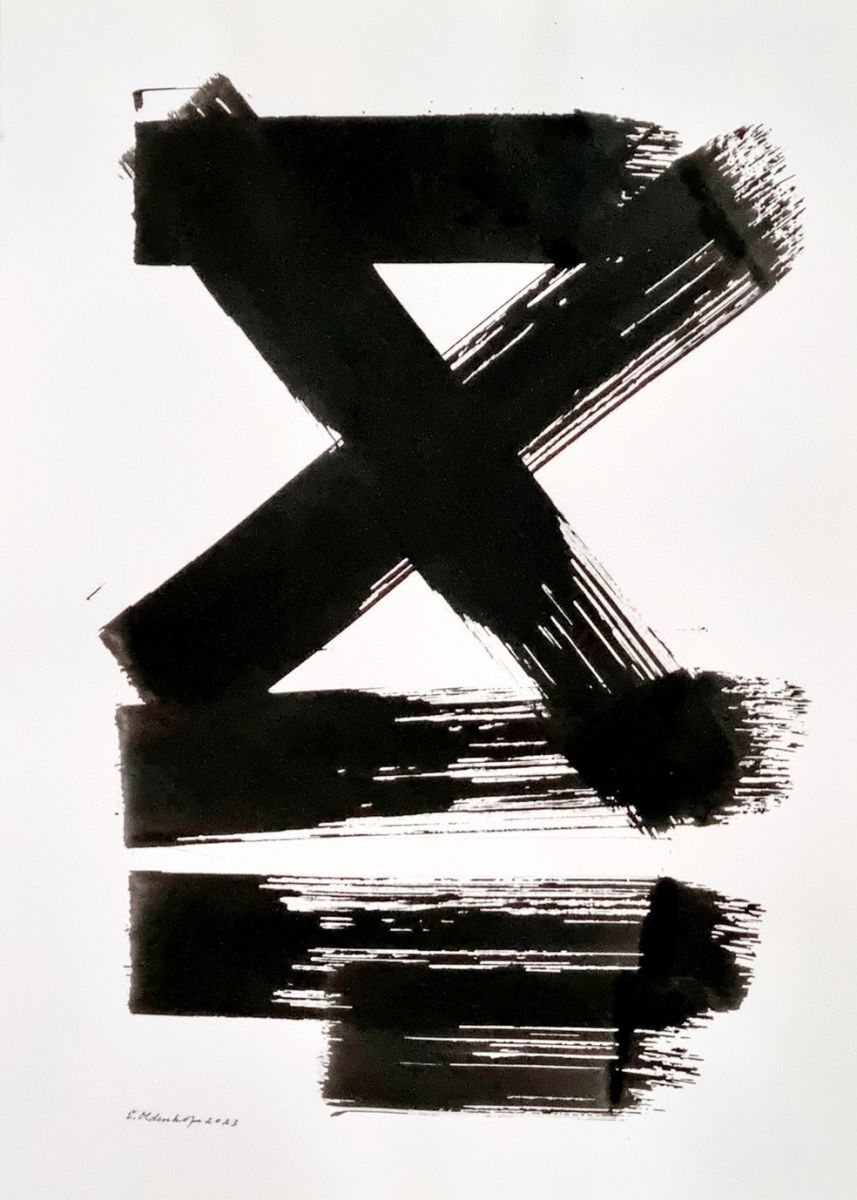esposizioni
Erik Oldenhof

Erik Oldenhof: "The power of minimal"
Dal 6 giugno al 27 giugno 2024 - dal martedì al giovedì 15.00/19.30
dal 1 ottobre al 31 ottobre solo su appuntamento: archivio@iginiobalderi.org
Inaugurazione giovedì 6 giugno ore 18.30
Atelier Balderi
Archivio Iginio Balderi, via Ausonio 20 – Milano
archivio@iginiobalderi.org
@archivioiginiobalderi
Dal 6 giugno 2024 fino al 31 ottobre presso lo spazio espositivo Atelier Balderi dell' Archivio Iginio Balderi di Milano in collaborazione con la fondazione olandese Galerie Conny van Kasteel, si apre la mostra dell’artista olandese Erik Oldenhof: "The Power of minimal" a cura di Ivo Balderi
In esposizione una selezione di più di venti quadri di grande e piccolo formato.

E_AJ42 - 2015 - Acrilico su linee - 80x80cm
Erik Oldenhof - Testo: Wim van der Beek
Erik Oldenhof, (Nijmegen 1951) è un pittore che applica il potere della limitazione nel suo modo di dipingere.
La semplicità è il segno distintivo del vero.
Si concentra interamente sulla ricerca della massima efficienza pittorica con il minimo di risorse visive. Caratteristico dei suoi dipinti è il gioco di linee pittoriche pastose che cadono sulla tela come un velo.
Dal 2004 Erik Oldenhof realizza dipinti monocromi in bianco ma anche rosso, blu e nero.
La sua ricerca pittorica risiede principalmente nell'uso delle molteplici sfumature del colore bianco.
Il bianco è il colore con cui può ricominciare ancora e ancora, da zero.
Questi dipinti monocromi sono dipinti bagnato su bagnato in tre diversi strati.
Usa alternativamente pennelli larghi e stretti e spatola mentre dipinge.
Oltre ad una spatola di legno per tracciare tracce nella vernice, recentemente ha utilizzato anche del nastro adesivo.
Questo nastro viene rimosso in direzioni opposte rispetto al tratto pittorico, creando un effetto ottico ritmico nella pelle pittorica che conferisce una tensione speciale al dipinto.
Ogni dipinto è un passo nella sua ricerca di cosa significhi per lui la pittura.
Non solo la pittura ma anche la pittura stessa è un modo di essere, per Erik Oldenhof.
Ricominciare ancora e ancora, alla ricerca dell'essenziale e del puro, questa è la sua motivazione.
L'illusione dell'infinito di linee conferisce all'opera un effetto spirituale e religioso.
Erik Oldenhof trascende questo perché persegue l'universale.
Il colore bianco di Erik Oldenhof e le linee che traccia non sono il colore e la linea della logica esistente ma dell’illimitatezza della nostra esistenza.
Può essere bello, può brillare di colori. Insomma, i suoi dipinti danno ampio spazio alla bellezza.

AN7 - 2019 - Acrilico su linee - 90x120 cm
“Luce, spazio e silenzio” - Testo: Marijke van Oppen.
Erik Oldenhof è nato a Nijmegen nel 1951 e ha trascorso la sua giovinezza nel villaggio di Mook.
Ha realizzato il suo primo dipinto all'età di 15 anni, ispirato dalla zia che gli ha dato i materiali per dipingere.
Conobbe l'arte per la prima volta attraverso la collezione di suo padre, che consisteva in dipinti di paesaggi dei pittori della Scuola Plasmolen attivi a Mook tra il 1940 e il 1950.
I suoi primi ricordi riguardano la lavanderia di suo padre. Le pile ordinatamente disposte di tovaglioli stirati e piegati e le tovaglie bianche sui tavoli di zinco hanno lasciato in lui un'impronta visibile nei suoi dipinti più recenti. Tracce del passato che inconsciamente si fanno strada nella pittura e nella tela.
Da bambino Erik Oldenhof era un sognatore. Uno dei suoi sogni era diventare architetto. L'architettura dell'epoca, soprattutto in stile Bauhaus con i suoi motivi geometrici astratti, è evidente nei dipinti della sua giovinezza.
Negli anni '70 ha studiato architettura a Nijmegen e ha lavorato per numerosi architetti praticanti. Il Museo Kröller-Müller di Otterlo, con la sua collezione di opere di Piet Mondriaan e Bart van der Leck, nonché le opere di Wladyslaw Strzeminiski gli hanno aperto gli occhi sulla grande tradizione della pittura astratta.
Viaggia a Roma, Firenze, Parigi e Madrid per studiare storia dell'arte, poi prosegue gli studi presso l'Accademia di Belle Arti di Amsterdam per affinare le sue capacità.
Il periodo successivo alla sua frequenza dell Accademia lo trascorse sperimentando nel suo nuovo studio ad Amsterdam. Realizzò paesaggi, studi di figure e i primi dipinti astratti. Oldenhof è stato fortemente ispirato dalle luci e dalla struttura dei paesaggi.
Nel corso degli anni il suo lavoro è diventato sempre più astratto e ogni residuo riferimento paesaggistico è scomparso nel processo. Ciò ha portato a una serie di monocromi neri e rossi del 1988-1989, ispirandosi a ZERO e alla Minimal Art.
Era chiaro fin dall'inizio che sarebbe diventato un pittore astratto. Il suo background in grafica e la sua formazione in architettura hanno giocato un ruolo fondamentale nello sviluppo del suo lavoro.
Da qui seguì un periodo di radicale riduzione delle immagini. Negli ultimi vent'anni le opere di Erik Oldenhof si riconoscono dalle molteplici sfumature di bianco. Le osservazioni sensoriali delle strutture dei dipinti sono diventate un fattore importante. L'immobilità che trasudano i suoi dipinti costringe l'osservatore a concentrarsi su una certa concentrazione. Sta cercando, secondo le sue stesse parole, qualcosa di intoccabile per raggiungere una scintilla super sensuale dell’immateriale.
Erik Oldenhof interroga gli elementi classici della pittura come il ritmo, le linee, la ripetizione della luce e il gioco delle ombre. Analizza coraggiosamente un modo per rispondere a queste domande.
Per Oldenhof, il colore bianco testimonia l'immobilità e la pura energia della luce e l'illusione dello spazio. Il suo lavoro è diretto, privo di coincidenze, le soluzioni chiare e convincenti, ma c'è sempre spazio per ulteriori ricerche. Le linee soffocanti dei suoi monocromi funzionano come accordi musicali.
I suoi dipinti invitano lo spettatore ad arrendersi agli aspetti emotivi e psicologici del continuo cambiamento. Si sforza di offrire allo spettatore una forma visionaria di bellezza, spazio e silenzio. Oldenhof è un artista che sceglie la propria strada e affina il visivo con una padronanza precisa e calcolata dei materiali.
Con questo approccio, nei suoi dipinti collega tra loro il contemporaneo e l'eterno e converte con successo l'ipotermia in un calore appassionato.
Disegni di Berlino (2018-2023)

Disegni di Berlino - 2024 - 29,7x40cm
Dal 2018 al 2023, Erik Oldenhof ha lavorato durante i mesi estivi in uno studio a Berlino, situato a Frohnau, una località del quartiere Reinickendorf di Berlino situata in una zona boscosa. I disegni di Berlino hanno avuto origine in questa zona appartata di pace e tranquillità.
Prima di partire per Berlino aveva deciso di limitare la scelta dei materiali e della tecnica. Ha scelto pennelli, inchiostro di china e penne a inchiostro per lavorare su carta di formato A3. Questa limitazione nei materiali da disegno e nel formato della carta gli ha permesso di concentrarsi con piena concentrazione, creando il proprio mondo interiore.
Il luogo sereno, la natura travolgente e il foglio di carta bianco come sfida. Come nei suoi dipinti, Erik Oldenhof ricerca una forma minima di astrazione attraverso una radicale riduzione dei mezzi pittorici.
Mentre studiava all'Accademia Gerrit Rietveld di Amsterdam (1974-1977), fu l'insegnante-grafico Ap Sok a motivarlo a realizzare xilografie in bianco e nero. Così in quel periodo emersero molte xilografie di paesaggi e composizioni astratte. Alla Rijksacademie Van Beeldende Kunsten di Amsterdam (1975-1979), ha realizzato numerosi studi di ritratti e figure in gesso siberiano dall'osservazione. Fu qui che sviluppò il gusto di lavorare in bianco e nero.
Nei suoi 40 anni di carriera come artista, ha ulteriormente sviluppato e perfezionato il disegno. Questi disegni di Berlino utilizzano due approcci al motivo. I disegni a pennello e poi i disegni con penne a inchiostro disegnati su strisce di inchiostro di china diluito. I disegni possono essere sereni e minimali oppure complessi e giocosi dal carattere trasparente. Sono visibili le influenze della Minimal Art, della Zero Art e dell'arte concreta. Un disegno a pennello può essere costituito da un singolo tratto di pennello o da una successione di tratti di pennello di inchiostro nero. In questo modo Erik Oldenhof si confronta scherzosamente con lo spettatore. I suoi disegni a pennello sono astrazioni sensibili che ricordano la calligrafia giapponese.
Il nero è un colore importante nella storia dell'arte visiva, si pensi al quadrato nero di Kazimir Malevich, che chiamò il suo quadrato nero -Il Volto di Dio-. Il nero suggerisce un’infinita profondità compressa di energia e calore.
Erik Oldenhof segue il suo intuito quando disegna; mano e occhio dialogano con il foglio di carta bianco. Per lui il disegno è una sintesi della distanza e della sua visione del mondo dell'inosservabile. Per un disegno di successo vengono realizzate diverse versioni, un disegno a inchiostro non può essere migliorato; solo il disegno riuscito rimane dopo un'attenta selezione, la ripetizione è memoria, è miglioramento.
Tutti i disegni sono realizzati in una cornice, lasciando un bordo bianco attorno all'immagine. In questo modo Erik Oldenhof crea un campo di tensione tra il disegno e lo spazio circostante. Con grande determinazione si bilancia tra scrittura e disegno, emergono strutture, è una ricerca tra contrasto, equilibrio e tensione. Le forme danzano sul foglio di carta come note musicali. All'interno di queste inesauribili variazioni, cerca qualcosa di incorporeo, una forma visionaria di bellezza.
I disegni trasparenti combinati con le penne a inchiostro, lo costringono a porre domande, a riflettere sull'atto del disegno per disegno. Anche qui segue la limitazione autoimposta, telaio, strisce di inchiostro trasparenti e penne di diverso spessore.
L'uso di penne sensibili alla pressione crea sottili modulazioni nel disegno al tratto. È un dialogo tra disegno al tratto e campi di inchiostro finché il disegno vibra di spaziosità architettonica. Le forme geometriche trovano il loro posto nella griglia di fasce di inchiostro trasparente sottostanti che danno una disposizione.
Questi Berlin Drawings sono un percorso guidato di pensiero preceduto da un lungo processo che non è mai lineare. Per Erik Oldenhof ogni disegno riuscito è una nuova realtà.
Amsterdam, febbraio 2023